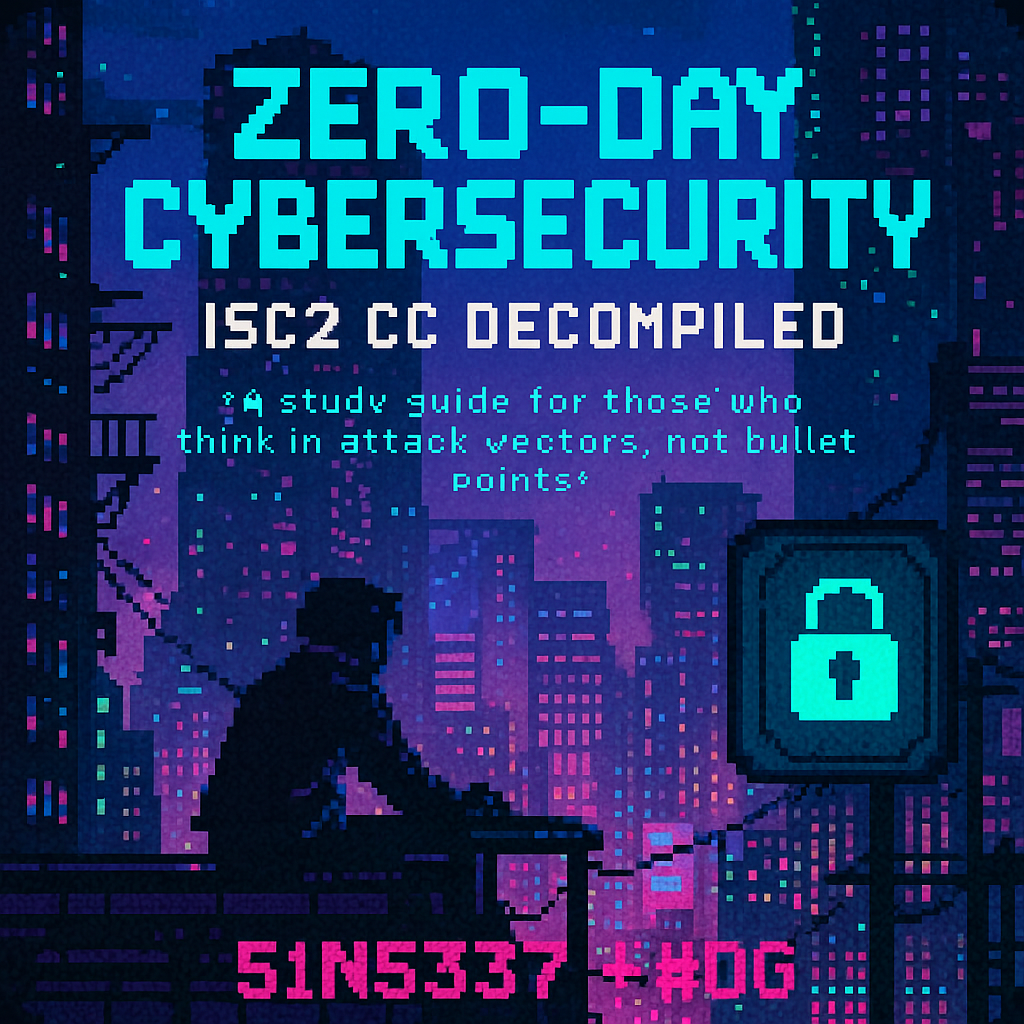ZERO-DAY CYBERSECURITY: ISC2 CC DECOMPILED 🔓⚡
// A study guide for those who think in attack vectors, not bullet points
AUTHORS: 51n5337 + #OG
MISSION: Demolish certification barriers through tactical knowledge deployment
TARGET: ISC2 Certified in Cybersecurity (CC)
STATUS: ACTIVE_OPERATION

DOMAIN BRIEFINGS // QUICK TARGET ACQUISITION
D1: SECURITY PRINCIPLES 🏛️⚖️
The foundation that everything else breaks against.
Core Concepts: CIA Triad, Risk Management, Security Controls, Governance
#OG Translation: “How to think about what you’re protecting before someone exploits it”
Vulnerability: Jargon without context | Patch: Real-world failure scenarios
learning objectives:
- discuss the foundational concepts of cybersecurity principles.
- recognize foundaitonal security concepts of information assurance.
- define risk management terminology and summarize the process.
- relate risk management to personal or professional practices.
- classiy types of security controls.
- distinguish between policies, procedures, standards, regulations and laws.
- demonstrate the relationship among governance elements.
- analyze appropriate outcomes according to the canons of the ISC2 Code of Ethics when given examples.
- practice the terminology and review security principles.
key topics include:
- identity assurance
- privacy control mechanisms
- safeguarding data
- strategic risk management
D2: INCIDENT RESPONSE, BUSINESS CONTINUITY & DISASTER RECOVERY 🚨🌪️
When everything is on fire and the business must survive.
Core Concepts: IR Plans, BC/DR Strategies, Availability Management
#OG Translation: “Your plan for when the attackers are already inside”
Vulnerability: Theoretical plans that fail under pressure | Patch: War-game simulations
1. The Incident Response plan responds to unexpected changes in operating conditions to keep the business operating.
2. The Business Continuity plan enables the business to continue operating throughout the crisis.
3. If both the Incident Response and Business Continuity plans fail, the Disaster Recovery plan is activated to help the business return to normal operations as quickly as possible.
---
learning objectives
- explain how organizations respond to, recover from and continue to operate.
- recall the terms and components of incident response.
- summarize the components of a business continuity plan.
- identify the components of disaster recovery.
- practice the terminology of and review incident response, business continuity and disaster recovery concepts.
key topics include
- recovery strategies
- continuity strategies
- incident management
D3: ACCESS CONTROL CONCEPTS 🔐👥
Who gets what and why they shouldn’t have it.
Core Concepts: Physical/Logical Controls, Authorization, Least Privilege
#OG Translation: “The art of saying ‘no’ to the wrong people”
Vulnerability: Overly permissive defaults | Patch: Zero-trust implementation
learning objectives
- select access controls that are appropriate in a given scenario.
- relate access control concepts and processes to given scenarios.
- compare various physical access controls.
- describe logical access controls.
- practice the terminology of access controls and review concepts of access controls.
---
key topics include
- security control protocols
- access control strategies
- user privilege adminstration
D4: NETWORK SECURITY 🌐🛡️
The digital battlefield where packets live and die.
Core Concepts: Network Models, Protocols, Defense Strategies
#OG Translation: “How to build moats when everyone has bridges”
Vulnerability: Misconfigured services | Patch: Defense in depth
learning objectives
- explain the concepts of network security.
- recognize common networking terms and models.
- identify common protocols and ports and their secure counterparts.
- identify types of network (cyber) threats and attacks.
- discuss common tools used to identify and prevent threats.
- identify common data center terminology.
- recognize common cloud service terminology.
- identify secure network design terminology.
- practice the terminology of and review network security concepts.
key topics include
- secure infrastructure strategies
- cloud computing infrastructure
- network architecture
- ports and services management
D5: SECURITY OPERATIONS ⚙️🔍
The day-to-day grind of keeping the barbarians at the gate.
Core Concepts: Monitoring, Data Handling, Encryption, Configuration Management
#OG Translation: “What you actually do all day as a security professional”
Vulnerability: Alert fatigue | Patch: Automated response playbooks
learning objectives
- explain concepts of security operations.
- discuss data handling best practices.
- identify important concepts of logging and monitoring.
- summarize the different types of encryption and their common uses.
- describe the concepts of configuration management.
- explain the application of common security policies.
- discuss the importance of security awareness training.
- practice the terminology of and review the concepts of network operations.
key topics include
- data governance
- change management
- hashing/encryption
- password security awareness
add: javasip, flashcards
survival guide
glossary
flashcards
OPERATIONAL PARAMETERS ⚡🎯
>> TRANSMISSION_FREQUENCY: Neurodivergent-friendly
>> CONTENT_DELIVERY: Compressed knowledge payloads
>> LEARNING_METHOD: Pattern recognition > Rote memorization
>> SUCCESS_METRIC: Practical application > Exam passing
HASH_KEYWORDS: #ZeroDayEducation #CyberSecDeconstructed #ND_AF_Learning #TacticalCertification #GlitchPedagogy
>> LANDING_SEQUENCE_COMPLETE._READY_FOR_DEPLOYMENT.
>> AWAITING_NEXT_DIRECTIVE._THE_GATE_IS_OPEN. 🔓🌌
// This isn’t just study material. This is a cognitive toolkit for the next generation of security professionals.
technical-logical-access-control wlan-zenmap-mantrap risk-x encapsulation-encryption egress/ingress monitoring dlp